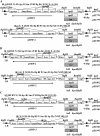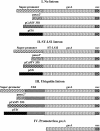Novel plant transformation vectors containing the superpromoter
- PMID: 17932307
- PMCID: PMC2151713
- DOI: 10.1104/pp.107.106633
Novel plant transformation vectors containing the superpromoter
Abstract
We developed novel plasmids and T-DNA binary vectors that incorporate a modified and more useful form of the superpromoter. The superpromoter consists of a trimer of the octopine synthase transcriptional activating element affixed to the mannopine synthase2' (mas2') transcriptional activating element plus minimal promoter. We tested a superpromoter-beta-glucuronidaseA fusion gene in stably transformed tobacco (Nicotiana tabacum) and maize (Zea mays) plants and in transiently transformed maize Black Mexican Sweet protoplasts. In both tobacco and maize, superpromoter activity was much greater in roots than in leaves. In tobacco, superpromoter activity was greater in mature leaves than in young leaves, whereas in maize activity differed little among the tested aerial portions of the plant. When compared with other commonly used promoters (cauliflower mosaic virus 35S, mas2', and maize ubiquitin), superpromoter activity was approximately equivalent to those of the other promoters in both maize Black Mexican Sweet suspension cells and in stably transformed maize plants. The addition of a maize ubiquitin intron downstream of the superpromoter did not enhance activity in stably transformed maize.
Figures







Similar articles
-
Promoter sequences from a maize pollen-specific gene direct tissue-specific transcription in tobacco.Mol Gen Genet. 1990 Nov;224(2):161-8. doi: 10.1007/BF00271548. Mol Gen Genet. 1990. PMID: 2277635
-
Characterization of a maize Wip1 promoter in transgenic plants.Int J Mol Sci. 2013 Dec 6;14(12):23872-92. doi: 10.3390/ijms141223872. Int J Mol Sci. 2013. PMID: 24322445 Free PMC article.
-
Genetically transformed maize plants from protoplasts.Science. 1988 Apr 8;240(4849):204-7. doi: 10.1126/science.2832947. Science. 1988. PMID: 2832947
-
Design of gene constructs for transgenic maize.Methods Mol Biol. 2009;526:3-20. doi: 10.1007/978-1-59745-494-0_1. Methods Mol Biol. 2009. PMID: 19378011 Free PMC article. Review.
-
Current status of binary vectors and superbinary vectors.Plant Physiol. 2007 Dec;145(4):1155-60. doi: 10.1104/pp.107.105734. Plant Physiol. 2007. PMID: 18056865 Free PMC article. Review. No abstract available.
Cited by
-
A dual-intein autoprocessing domain that directs synchronized protein co-expression in both prokaryotes and eukaryotes.Sci Rep. 2015 Feb 25;5:8541. doi: 10.1038/srep08541. Sci Rep. 2015. PMID: 25712612 Free PMC article.
-
MISSA is a highly efficient in vivo DNA assembly method for plant multiple-gene transformation.Plant Physiol. 2010 May;153(1):41-51. doi: 10.1104/pp.109.152249. Epub 2010 Mar 3. Plant Physiol. 2010. PMID: 20200068 Free PMC article.
-
Characterizing standard genetic parts and establishing common principles for engineering legume and cereal roots.Plant Biotechnol J. 2019 Dec;17(12):2234-2245. doi: 10.1111/pbi.13135. Epub 2019 May 23. Plant Biotechnol J. 2019. PMID: 31022324 Free PMC article.
-
Efficient chimeric plant promoters derived from plant infecting viral promoter sequences.Planta. 2014 Feb;239(2):381-96. doi: 10.1007/s00425-013-1973-2. Epub 2013 Nov 1. Planta. 2014. PMID: 24178585
-
Identification of F-box proteins in ABA- and GA-regulated seed germination: interaction of GASA1 signalling peptide and ABA-induced ubiquitination.Philos Trans R Soc Lond B Biol Sci. 2025 May 29;380(1927):20240233. doi: 10.1098/rstb.2024.0233. Epub 2025 May 29. Philos Trans R Soc Lond B Biol Sci. 2025. PMID: 40439299
References
-
- Becker D, Kemper E, Schell J, Masterson R (1992) New plant binary vectors with selectable markers located proximal to the left T-DNA border. Plant Mol Biol 20 1195–1197 - PubMed
-
- Butaye KMJ, Goderis IJWM, Wouters PFJ, Pues JMTG, Delaure SL, Broekaert WF, Depicker A, Cammue BPA, DeBolle FC (2004) Stable high-level transgene expression in Arabidopsis thaliana using gene silencing mutants and matrix attachment regions. Plant J 39 440–449 - PubMed
-
- Callis J, Fromm M, Walbot V (1987) Introns increase gene expression in cultured maize cells. Genes Dev 1 1183–1200 - PubMed
-
- Christensen AH, Sharrock RA, Quail PH (1992) Maize polyubiquitin genes: structure, thermal perturbation of expression and transcript splicing, and promoter activity following transfer to protoplasts by electroporation. Plant Mol Biol 18 675–689 - PubMed
-
- Cornejo MJ, Luth D, Blankenship KM, Anderson OD, Blechl AE (1993) Activity of maize ubiquitin promoter in transgenic rice. Plant Mol Biol 23 567–581 - PubMed
Publication types
MeSH terms
Substances
Associated data
- Actions
- Actions
- Actions
LinkOut - more resources
Full Text Sources
Other Literature Sources

